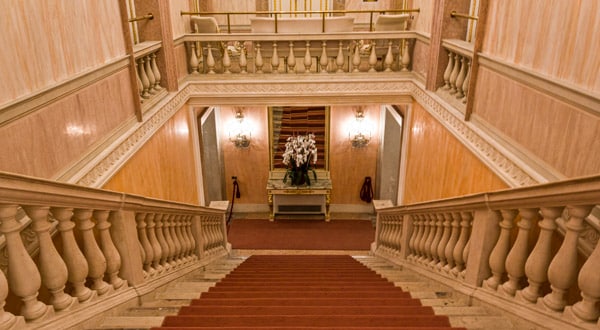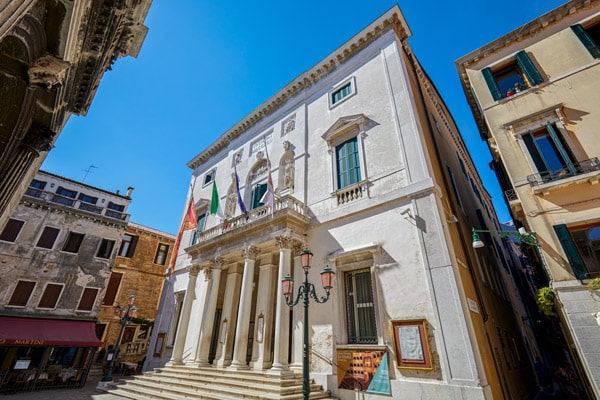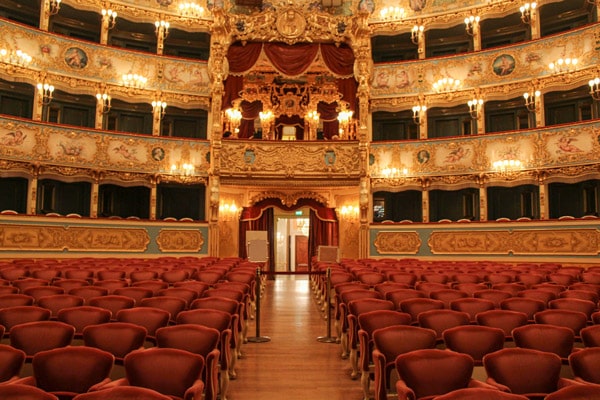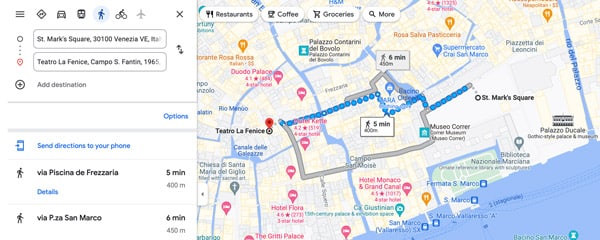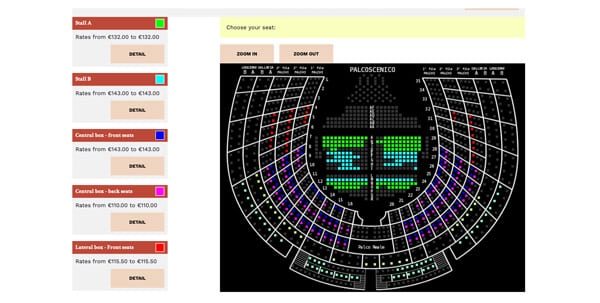La Fenice is an 18th-century opera house that is Venice’s premier opera house and one of the most prestigious in the world. It has hosted premieres of works by great composers such as Giuseppe Verdi, Gioachino Rossini, Vincenzo Bellini and Gaetano Donizetti.
Page Contents
Appearance History
It is known that the first public opera house under the name Teatro San Cassiano appeared in Venice in 1637. Its architectural plan and structure subsequently defined the tradition of musical theaters in Italy and throughout Europe.
At the end of the 18th century, there were two opera houses in Venice. One of them, the Teatro San Benedetto, was the most magnificent of all, including the city’s seven ancient and two dramatic theaters.
The glory of San Benedetto faded when, as a result of litigation, in 1780, the theater building passed into the ownership of the owner of the land on which it stood, the rich Venier family. Shortly before that, in 1774, the theater burned down, after which it was in deplorable condition.
The company that ran San Benedetto decided to build a new and larger theater, which would be called the Gran Teatro La Fenice. The name became a symbol of the fickle destiny of the theater and its ability to “revive”.
First of all, land in Sant’Angelo and Santa Maria Zobenigo was acquired, and a competition was announced for the design of a theater building that would be pleasing to the eyes and ears of the audience.
Out of nine applicants, who submitted a total of 28 projects, the winner was the architect Giannantonio Selva. He exhibited a wooden model of the theater, which delighted the jury and which, incidentally, has been preserved to this day.
Project
The architect Giannantonio Selva realized the project, taking into consideration the 14 points set out in advance by the client. Mainly they corresponded to the general style of Italian opera houses that first appeared in Venice in the middle of the 16th century.
Five tiers in the traditional form of a horseshoe were built in the theater hall. The choice in favor of “small boxes according to the Italian tradition” met the two main requirements – a good view of the stage and excellent acoustics. Incidentally, all 174 boxes were exactly the same, thus underscoring the Republican theater’s ideal of equality for all audiences.
In such a unique city as Venice, the privileged audience did not walk but sailed up to the theater. The architect envisioned a sufficiently wide second entrance on the side of the small Rio Menuo canal that a gondola could enter.
One of the most important requirements of the architect was protection from fire or at least the rapid restoration of structures damaged by fire.
Premieres and highlights
From 1792 to 1814, a series of world premieres took place at La Fenice. In 1807 alone, the public was presented:
- “Stefano Pavesi’s I cherusci,
- “The skill of choosing a worthy spouse, that is, true love and interested love” (Sapersi scegliere un degno sposo ossia Amor vero e amor interessato) by Stefano Pavesi,
- “Metamorphoses” (Le metamorfosi) by Vincenzo Lavigne,
- “Beautiful talks and sad facts” (Belle ciarle e tristi fatti) by Johann Simon Mair.
Gioachino Rossini staged two famous productions at La Fenice: Tancredi in 1813 and Semiramide in 1823.
An equally memorable event for the theater was the visit of Napoleon in December 1807. In honor of the famous guest, the auditorium was decorated in the sky-blue and silver colors of the Empire style, and the cantata Il giudizio di Giove by Corniani d’Algarotti Lauro was performed on stage.
Since La Fenice, after the visit of Bonaparte, essentially took on the role of the state theater, it became obvious the need for a government stage and a separate lodge for the sovereign.
The first reconstructions
The interior of the auditorium was renovated in 1822 as a result of the renovations that took place. At the premiere performance of Meyer’s opera Il ritorno di Ulisse, the audience could already contemplate the new imperial box and the stage decoration. The latter was decorated by Italian painters Giuseppe Borsato, Giambattista Canal, Costantino Cedini, Pietro Moro.
A more serious reconstruction was carried out between 1825 and 1828, commissioned by the governing authority, which considered that the weather and the soot from the candles had made the theater look inadequate.
The work was again directed by Giuseppe Borsato, the official stage designer of La Fenice. A magnificent crystal chandelier appeared on the vault of the auditorium, a clock face showing midnight appeared on the stage, and the decoration of the parapets of the boxes was ornamented with acanthus leaves, images of musical instruments, masks, and geniuses.
Fires
As history has shown, theaters built with wooden constructions and dangerous methods of lighting have often been burned by an accidental fire. Unfortunately, the new theater in Venice did not escape this fate.
The fire of 1836. Restoration
The Teatro La Fenice burned twice. The first dramatic event occurred on December 13, 1836. The fire broke out due to a malfunction of the Austrian heater that had just been installed. The newspapers of the time wrote that it took three days to extinguish the fire, but even afterward, some flames could still be seen. As a result, only the foyer and the Halls of Apollonia (and Sale Apollinee) were saved from destruction.
The architect brothers Tommaso and Giovanni Battista Meduna restored the theater to its original design. The elegant interior decoration, including the ceiling of the auditorium, was done by Tranquillo Orsi. Renovated decoration also appeared in the atrium, the main box, and partially on the facade of the building.
One year later, on December 26, 1837, La Fenice was again enlivened by a splendid decoration, reborn as the Phoenix bird from the ashes. This was celebrated with the world premiere of Rosmunda in Ravenna by Giuseppe Lillo.
The music of the great composers resumed in the renovated theater. From 1844 to 1858 on the stage of La Fenice were premiered operas of Giuseppe Verdi – Ernani, Attila, Rigoletto, La Traviata and Simon Boccanegra.
1996 fire. Restoration
The second fire, which occurred on the night of January 26, 1996, was not accidental. Instead, the company, carrying out repairs to the building at the time, was facing a hefty fine for not meeting its deadline.
The theater building burned down in two hours, and it was only a miracle that the fire did not spread to nearby houses. The damage was extensive, and water dropped by firefighters from a helicopter finally brought down the fragile structures. Only the facade and the bare perimeter walls remained.
ATI Holzmann won the €90 million tenders for the construction work with the design by Aldo Rossi. A team of over 200 people, including painters, plasterers, carpenters, and other craftsmen, were working to recreate the atmosphere of the old theater. In his project, Aldo Rossi was guided by the motto of the reconstruction of the Basilica di San Marco: “As it was, where it was.” The architect was also able to obtain detailed information about the design of the theater from the photographs of the first scenes of the film Senso directed by Luchino Visconti in 1954, which was filmed in La Fenice before the fire.
The theater today
All reconstructions of the theater, after a fire and simply for renovating the interior, have always been carried out with the utmost care for the surviving fragments. This approach allows us to read the building history of La Fenice in its current appearance, defined primarily by the façade, the auditorium, and the beautiful public spaces.
Facade
The theater is located in the San Marco area with the main entrance on Campo San Fantin.
The Neoclassical façade, built in 1792 and designed by the architect Giannantonio Selva, is the only element of the building to have survived two fires. In its center is the emblem of the theater, the phoenix rising from the tongues of flame, made in 1837 according to a design by Giambattista Meduna.
The statues in niches represent Melpomene, the muse of tragedy, and Terpsichore, the muse of dance; the masks above them represent Comedy and Tragedy.
Theater Hall
The 1,000-seat theater hall is impressively decorated in rococo style. The main space of the theater has been reconstructed on the basis of a careful photographic study of its old design as well as a detailed tract of the 1836 reconstruction compiled by the Medun brothers.
Today, all the boxes are equally decorated with nineteenth-century materials-gold moldings, papier-mache, and wood. The scenic effect is enhanced by 22 nerides on the cornice and four putti in the royal box.
The ceiling imitates a dome vault with images of muses and graces on the blue background. The magnificent crystal chandelier is a reproduction of the gilded-bronze original from England that was commissioned by the Medun brothers from Liverpool in 1854.
Above the first level of the lodge are the profiles of classical poets, above the second are six allegories (history, poetry, philosophy, comedy, tragedy, and music), and above the third are tablets with engraved authors’ names and the names of the 14 most essential operas staged at La Fenice.
The dark green curtain is also a reference to the original. It is made of fire-resistant synthetic velvet decorated with gilded leather flowers.
Apollonia Halls
The five ceremonial halls of La Fenice are named after Apollo, the god Apollo, father of the Muses, and patron of the arts. The Halls of Apollinee (Sale Apollinee) are filled with the public during the breaks in the performances, and previously they were also used as a rehearsal room, ballet room, café, and billiard room.
Sala Grande, the main chamber music hall, book presentations, and other important cultural events. It is now fully restored to match the original.
The Sala Dante (Sala Dante), opened in 1865 in honor of the 600th anniversary of the great Italian poet, houses the theater’s main bar. It is decorated with frescoes by the painter Giacomo Casa with themes from the works of Dante.
How to get there
The Teatro La Fenice is located in the historic center of Venice, Campo S. Fantin, 1965, 30124 Venezia VE, Italy. The distance from Piazza San Marco is 400 meters. It takes 5 minutes to walk.
Opening times and tickets
For tourists, the Opera House La Fenice is open daily from 09:30 to 18:00. Adult ticket costs 13 Euro,Family ticket (2 adults +1 child) costs 24 Euro. Avoiding the queue if you take care of your tickets in advance and buy them online is possible.
Opera performances and symphonic concerts are held several times a week and usually start at 20:00. It is advisable to reserve tickets at least a month in advance, and the cost ranges from 77 to 150 euros.
For a schedule of concerts and to buy tickets, visit the theater’s official website under the calendar section at www.teatrolafenice.it/calendario/
La Fenice lives not only on classical productions of the past. The theater’s repertoire is constantly being enriched by contemporary works.
The New Year’s Concert (or “Venice New Year’s Eve Concert”), held for the first time on January 1, 2004, in honor of the theater’s reconstruction after a fire, has become a wonderful tradition. Since then, it has been broadcast live to several countries each year and ends with a toast from Giuseppe Verdi’s La Traviata – “Let us lift up the cups of merriment (Libiamo ne lieti calici).
These words remind us that the purpose of theater is to give people joy and fill their souls with music.
 Italy for me From Italy with love
Italy for me From Italy with love




